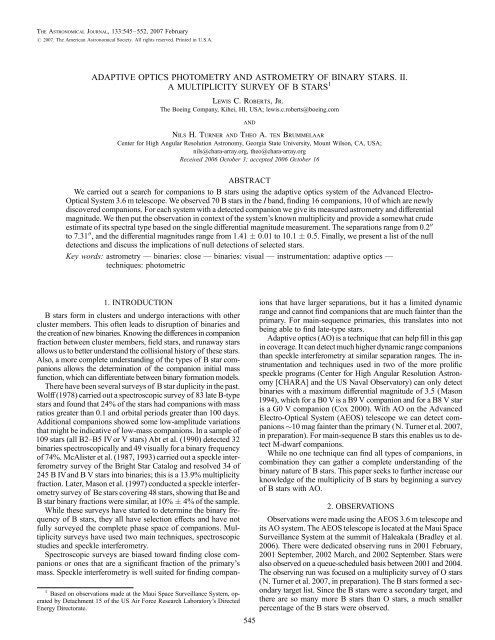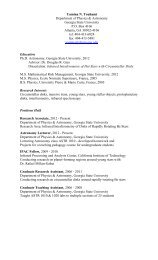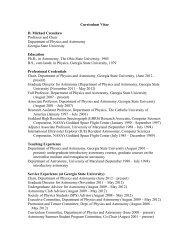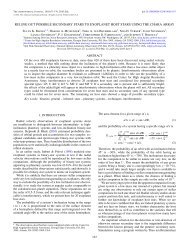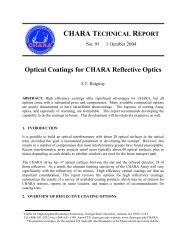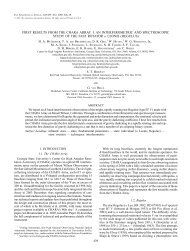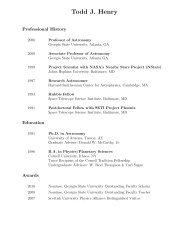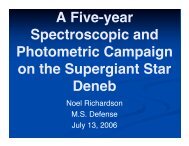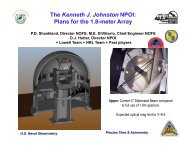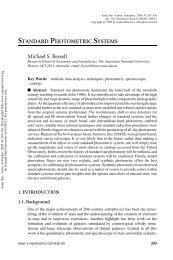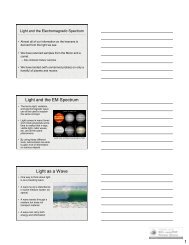Adaptive Optics Photometry and Astrometry of Binary Stars. II. A ...
Adaptive Optics Photometry and Astrometry of Binary Stars. II. A ...
Adaptive Optics Photometry and Astrometry of Binary Stars. II. A ...
You also want an ePaper? Increase the reach of your titles
YUMPU automatically turns print PDFs into web optimized ePapers that Google loves.
The Astronomical Journal, 133:545Y552, 2007 February# 2007. The American Astronomical Society. All rights reserved. Printed in U.S.A.ADAPTIVE OPTICS PHOTOMETRY AND ASTROMETRY OF BINARY STARS. <strong>II</strong>.A MULTIPLICITY SURVEY OF B STARS 1Lewis C. Roberts, Jr.The Boeing Company, Kihei, HI, USA; lewis.c.roberts@boeing.com<strong>and</strong>Nils H. Turner <strong>and</strong> Theo A. ten BrummelaarCenter for High Angular Resolution Astronomy, Georgia State University, Mount Wilson, CA, USA;nils@chara-array.org, theo@chara-array.orgReceived 2006 October 3; accepted 2006 October 16ABSTRACTWe carried out a search for companions to B stars using the adaptive optics system <strong>of</strong> the Advanced Electro-Optical System 3.6 m telescope. We observed 70 B stars in the I b<strong>and</strong>, finding 16 companions, 10 <strong>of</strong> which are newlydiscovered companions. For each system with a detected companion we give its measured astrometry <strong>and</strong> differentialmagnitude. We then put the observation in context <strong>of</strong> the system’s known multiplicity <strong>and</strong> provide a somewhat crudeestimate <strong>of</strong> its spectral type based on the single differential magnitude measurement. The separations range from 0.2 00to 7.31 00 , <strong>and</strong> the differential magnitudes range from 1:41 0:01 to 10:1 0:5. Finally, we present a list <strong>of</strong> the nulldetections <strong>and</strong> discuss the implications <strong>of</strong> null detections <strong>of</strong> selected stars.Key words: astrometry — binaries: close — binaries: visual — instrumentation: adaptive optics —techniques: photometric1 Based on observations made at the Maui Space Surveillance System, operatedby Detachment 15 <strong>of</strong> the US Air Force Research Laboratory’s DirectedEnergy Directorate.1. INTRODUCTIONB stars form in clusters <strong>and</strong> undergo interactions with othercluster members. This <strong>of</strong>ten leads to disruption <strong>of</strong> binaries <strong>and</strong>the creation <strong>of</strong> new binaries. Knowing the differences in companionfraction between cluster members, field stars, <strong>and</strong> runaway starsallows us to better underst<strong>and</strong> the collisional history <strong>of</strong> these stars.Also, a more complete underst<strong>and</strong>ing <strong>of</strong> the types <strong>of</strong> B star companionsallows the determination <strong>of</strong> the companion initial massfunction, which can differentiate between binary formation models.There have been several surveys <strong>of</strong> B star duplicity in the past.Wolff (1978) carried out a spectroscopic survey <strong>of</strong> 83 late B-typestars <strong>and</strong> found that 24% <strong>of</strong> the stars had companions with massratios greater than 0.1 <strong>and</strong> orbital periods greater than 100 days.Additional companions showed some low-amplitude variationsthat might be indicative <strong>of</strong> low-mass companions. In a sample <strong>of</strong>109 stars (all B2YB5 IVor V stars) Abt et al. (1990) detected 32binaries spectroscopically <strong>and</strong> 49 visually for a binary frequency<strong>of</strong> 74%. McAlister et al. (1987, 1993) carried out a speckle interferometrysurvey <strong>of</strong> the Bright Star Catalog <strong>and</strong> resolved 34 <strong>of</strong>245 B IV<strong>and</strong> B V stars into binaries; this is a 13.9% multiplicityfraction. Later, Mason et al. (1997) conducted a speckle interferometrysurvey <strong>of</strong> Be stars covering 48 stars, showing that Be <strong>and</strong>B star binary fractions were similar, at 10% 4% <strong>of</strong> the sample.While these surveys have started to determine the binary frequency<strong>of</strong> B stars, they all have selection effects <strong>and</strong> have notfully surveyed the complete phase space <strong>of</strong> companions. Multiplicitysurveys have used two main techniques, spectroscopicstudies <strong>and</strong> speckle interferometry.Spectroscopic surveys are biased toward finding close companionsor ones that are a significant fraction <strong>of</strong> the primary’smass. Speckle interferometry is well suited for finding companionsthat have larger separations, but it has a limited dynamicrange <strong>and</strong> cannot find companions that are much fainter than theprimary. For main-sequence primaries, this translates into notbeing able to find late-type stars.<strong>Adaptive</strong> optics (AO) is a technique that can help fill in this gapin coverage. It can detect much higher dynamic range companionsthan speckle interferometry at similar separation ranges. The instrumentation<strong>and</strong> techniques used in two <strong>of</strong> the more prolificspeckle programs (Center for High Angular Resolution Astronomy[CHARA] <strong>and</strong> the US Naval Observatory) can only detectbinaries with a maximum differential magnitude <strong>of</strong> 3.5 (Mason1994), which for a B0 V is a B9 V companion <strong>and</strong> for a B8 V starisaG0Vcompanion(Cox2000).WithAOontheAdvancedElectro-Optical System (AEOS) telescope we can detect companions10 mag fainter than the primary (N. Turner et al. 2007,in preparation). For main-sequence B stars this enables us to detectM-dwarf companions.While no one technique can find all types <strong>of</strong> companions, incombination they can gather a complete underst<strong>and</strong>ing <strong>of</strong> thebinary nature <strong>of</strong> B stars. This paper seeks to further increase ourknowledge <strong>of</strong> the multiplicity <strong>of</strong> B stars by beginning a survey<strong>of</strong> B stars with AO.2. OBSERVATIONSObservations were made using the AEOS 3.6 m telescope <strong>and</strong>its AO system. The AEOS telescope is located at the Maui SpaceSurveillance System at the summit <strong>of</strong> Haleakala (Bradley et al.2006). There were dedicated observing runs in 2001 February,2001 September, 2002 March, <strong>and</strong> 2002 September. <strong>Stars</strong> werealso observed on a queue-scheduled basis between 2001 <strong>and</strong> 2004.The observing run was focused on a multiplicity survey <strong>of</strong> O stars(N. Turner et al. 2007, in preparation). The B stars formed a secondarytarget list. Since the B stars were a secondary target, <strong>and</strong>there are so many more B stars than O stars, a much smallerpercentage <strong>of</strong> the B stars were observed.545
546 ROBERTS, TURNER, & TEN BRUMMELAARVol. 133TABLE 1B Star BinariesHD WDS Discovery Hipparcos Besselian(arcsec) a(deg) bI3369................................... 00369+3343 RBR 3 Aab 2912 2001.7424 0.20 265.1Z/97.6N 8.7 1.8 c5394................................... 00567+6043 BU 1028 AB 4427 2002.6845 2.07 259.0 6.85 0.1823862................................. 03492+2408 RBR 4 Aab 17851 2002.0924 4.66 221Z/119N 9.4 0.5 c37711................................. 05413+1632 BU 1007 26777 2001.0985 0.26 221.2 1.51 0.03 d44458................................. 06214 1146 STF 3116 AB 30214 2003.9873 3.90 22.7 3.69 0.01100600............................... 11347+1648 STF 1552 AB 56473 2002.2407 3.41 205.8 1.41 0.01106625............................... 12158 1733 RBR 5 AB 59803 2002.2408 1.06 96.8 7.1 1.0 c120198............................... 13466+5426 RBR 6 Aa 67231 2002.2410 2.42 115.9 10.1 1.0 c135742............................... 15170 0923 RBR 7 AB 74785 2002.2411 2.09 194.2 8.8 0.5 c157039............................... 17227 3748 B908 AB 85020 2001.4686 2.71 114.5 6.0 0.1 e164863............................... 18042 2230 B1975 BC ... 2001.6710 0.47 236.0 4.90 0.30 e2002.6729 0.47 235.5 4.65 0.22164906............................... 18044 2423 RBR 8 AB ... 2001.6710 3.14 318.3 8.04 0.37 c170938............................... 18326 1542 RBR 9 AB 90907 2001.7364 7.31 250.2Z/218.1N 7.23 0.22 c171432............................... 18356 1833 RBR 10 AB 91143 2002.5474 4.86 320.0 10.6 0.5 c174638............................... 18501+3322 RBR 11 Aa 92420 2002.6731 0.54 176.3 4.53 0.20 c183914............................... 19307+2758 RBR 12 Ba 95951 2002.6842 0.39 107.5 4.12 0.17 ca Errors in this column are 0.02 00 for 1 00 , 0.01 00 for 1 00 < 4 00 , <strong>and</strong> 0.02 00 for >4 00 .b The position angles all have an error <strong>of</strong> 2 .c New discovery.d This measurement was made using the 700Y1060 nm filter.e Confirmation observation.An observing list <strong>of</strong> observable B stars was compiled from theSIMBAD database. 2 <strong>Stars</strong> were chosen so that they had zenithangles <strong>of</strong> 45 (declinations from 24.3 to +65.75 ) <strong>and</strong> werebrighter than 9 mag in the V b<strong>and</strong>. The brightness limit was chosenbecause the AEOS AO system has a limiting magnitude <strong>of</strong> approximately9 mag, although the exact limit depends on atmosphericconditions. This created a list with 3113 stars. In the endwe observed 70 stars, or 2.2% <strong>of</strong> the available stars. The smallpercentage <strong>of</strong> the available targets that were observed limits theamount <strong>of</strong> statistical analysis that can be applied the sample.The AEOS AO system is a natural guide star system using aShack-Hartmann wave front sensor (Roberts & Neyman 2002).The individual subaperatures have a diameter <strong>of</strong> 11.9 cm projectedonto the primary. The deformable mirror has 941 actuators.The system’s closed-loop b<strong>and</strong>width is adjustable <strong>and</strong> can run upto 200 Hz, although the normal range is approximately 50 Hz.In the configuration used for these observations, the light from 500to 540 nm is sent to the tip-tilt detector system, the light from 540to 700 nm is sent to the wave front sensor, <strong>and</strong> the light longer than700 nm is sent to the Visible Imager CCD science camera.Each data set consists <strong>of</strong> 1000 frames using a Bessel I-b<strong>and</strong>filter. After collection, any saturated frames are discarded, <strong>and</strong> theremaining frames are debiased, dark-subtracted, <strong>and</strong> flat-fielded.The frames are weighted by their peak pixel, which is proportionalto their Strehl ratio, <strong>and</strong> then co-added using a shift-<strong>and</strong>-add routine.The resulting image is analyzed with the program fitstars;ituses an iterative blind deconvolution that fits the location <strong>of</strong> deltafunctions <strong>and</strong> their relative intensity to the data. The co-addingtechnique <strong>and</strong> the analysis with fitstars were first presented in tenBrummelaar et al. (1996). Upgrades to fitstars were discussed inten Brummelaar et al. (2000) <strong>and</strong> Roberts et al. (2005).Error bars on the astrometry <strong>and</strong> photometry were assignedusing the method in Roberts et al. (2005). For the photometry,simulated binary stars were created from observations <strong>of</strong> singlestars. The photometry <strong>of</strong> these simulated binaries was measured2 The SIMBAD database can be found at http://simbad.u-strasbg.fr.<strong>and</strong> used to create a grid <strong>of</strong> measurement errors as a function <strong>of</strong>separation <strong>and</strong> differential magnitudes. For astrometry, the separationerror bar is 0.02 00 for 1 00 , 0.01 00 for 1 00 < 4 00 ,<strong>and</strong> 0.02 00 for >4 00 . In Roberts et al. (2005) we mistakenlyclaimed that the position angle error is a constant. This is not true;the error in position angle caused by errors in determining the centroid<strong>of</strong> the secondary star location is bigger for systems with smallseparations than for those with larger separations. We have adopted2 for 1 00 as our position angle error bar.3. RESULTSThe rest <strong>of</strong> the paper is laid out in the following way: first, wediscuss how we estimated a spectral type for any detected companions.Then we start discussing individual systems. We discussobservations <strong>of</strong> binaries for which we detected componentsthat are already known in x 3.2. Next, we discuss the detection <strong>of</strong>new components <strong>of</strong> binary systems in x 3.3. The astrometry <strong>and</strong>photometry for all binaries is shown in Table 1. Of course, we didnot detect companions to all the stars we observed. These aredescribed in Table 2. In x 3.5, we discuss binaries for which wedid not detect the previously known companions.3.1. Companion Spectral TypeFor stars where we detected another object in the field <strong>of</strong> view,we estimated the possible companion spectral type using the absolutemagnitudes <strong>of</strong> the MK classification in Cox (2000). There areonly data for luminosity classes V<strong>and</strong> I, so for luminosity classes IV<strong>and</strong> <strong>II</strong>I we used the main-sequence data, while for luminosityclasses <strong>II</strong> <strong>and</strong> I we used the supergiant data. We assumed that thecompanion was physically bound to the primary <strong>and</strong> was on themain sequence. If the primary is an unresolved binary, this willcontaminate the spectral type <strong>of</strong> the primary <strong>and</strong> cause an errorin the determination <strong>of</strong> the spectral type <strong>of</strong> the AO-resolvedcompanion. The results are discussed in the sections detailingthe individual stars.Admittedly this is a fairly crude way <strong>of</strong> spectral typing, but itis all that is available until multifilter observations are done. With
No. 2, 2007AO PHOTOMETRY AND ASTROMETRY OF BINARIES. <strong>II</strong>. 547TABLE 2—ContinuedTABLE 2Single B <strong>Stars</strong>HD WDS Hipparcos Besselian YearFWHM(arcsec)224926................ ... 145 2002.6843 0.12225132................ ... 301 2002.6844 0.122002.6844 0.17225289................ ... 418 2002.6844 0.17358...................... 00084+2905 677 2001.7423 0.12 a,b886...................... 00132+1511 1067 2001.7424 0.10 b3901.................... ... 3300 2001.7425 0.144142.................... ... 3478 2002.6844 0.104727.................... ... 3881 2001.7425 0.1410205.................. 01406+4035 7818 2001.7425 0.12 b12534.................. 02039+4220 ... 2001.7426 0.12 b15318.................. ... 11484 2001.7426 0.1216582.................. ... 12387 2001.7427 0.1116908.................. ... 12719 2001.7427 0.112001.7427 0.1217573.................. 02500+2716 13209 2001.7427 0.10 c18604.................. ... 13954 2001.7428 0.1219356.................. 03082+4057 14576 2001.7456 0.082001.8656 0.1019698.................. ... 14764 2001.7428 0.1223630.................. 03475+2406 17702 2001.7428 0.10 b24398.................. 03541+3153 18246 2001.7429 0.10 b24760.................. 03579+4001 18532 2001.7429 0.12 b38771.................. ... 27366 2002.7392 0.2383754.................. ... 47452 2002.2405 0.1786360.................. ... 48883 2002.2405 0.1087015.................. ... 49220 2002.2406 0.0887504.................. ... 4940 2002.2406 0.09104337................ ... 58587 2002.2407 0.172002.2407 0.10106625................ ... 59803 2002.2408 0.26113797................ ... 63901 2002.2410 0.12116658................ 13252 1110 65474 2002.2408 0.13 b2002.2409 0.08 b120315................ ... 67301 2002.2410 0.08148688................ ... 80945 2001.3891 0.11149038................ ... 81122 2004.2589 0.23152235................ ... 82669 2001.3893 0.12154450................ ... ... 2001.4030 0.202001.4957 0.17158902................ ... 85881 2001.4686 0.12160762................ 17395+4600 86414 2002.6839 0.16 b,c163302................ ... ... 2001.3399 0.23164637................ ... 88396 2001.5179 0.12165516................ ... 88760 2001.6711 0.11168987................ ... ... 2002.6785 0.14169454................ ... 90281 2001.6712 0.102001.7364 0.18170938................ ... 90907 2001.6712 0.24171012................ ... 90950 2002.4518 0.12176437................ 18589+3241 93194 2002.6732 0.08 b177756................ ... 93805 2002.6839 0.122002.6841 0.12187235................ 19475+3824 97376 2002.6843 0.14 b196867................ 20396+1555 101958 2001.7420 0.10 a,b207330................ 21468+4919 107533 2001.7449 0.09 a212120................ 22210+4632 110351 2001.7450 0.08 b213998................ ... 111497 2001.7449 0.09HD WDS Hipparcos Besselian Yearseveral filters, fairly accurate spectral typing can be done (tenBrummelaar et al. 2000).The results from this analysis are shown in Table 3. The tablehas the Henry Draper (HD) catalog number <strong>of</strong> the star, the I fromTable 1, the literature value for the spectral type <strong>of</strong> the primary, <strong>and</strong>the derived spectral type <strong>of</strong> the secondary. <strong>Stars</strong> for which thelater part <strong>of</strong> the range was later than an M5 spectrum have thelater type was listed as a dash.3.2. Known BinariesIn this subsection <strong>of</strong> the paper, we discuss the measurements<strong>of</strong> known binary stars, for which we observed the previouslyknown components. Section 3.3 discusses newly detected companions.The astrometry <strong>and</strong> photometry <strong>of</strong> all the binary starsare presented in Table 2. For each star we give the WashingtonDouble Star (WDS) number, the discovery designation, the HDcatalog number, the Hipparcos catalog number, the Besseli<strong>and</strong>ate <strong>of</strong> the observation, the separation in arcseconds, the positionangle in degrees, <strong>and</strong>, finally, the differential magnitude measuredin the Bessel I b<strong>and</strong> along with an error. We make notes <strong>of</strong>TABLE 3Companion Spectral TypeHD I SP1 SP23369................................ 8.7 1.8 B5 V a K6 V—5394................................ 6.85 0.18 B0 IV b F2YG0 V23862.............................. 9.4 0.5 B8nn c M5 V—37711.............................. 1.51 0.03 B3 IV d B5YB8 V44458.............................. 3.69 0.01 B1 V b B8YA0 V100600............................ 1.41 0.01 B4 V e B8YA0 V106625............................ 7.1 1.0 B8 <strong>II</strong>I f K5YM5 V120198............................ 10.1 1.0 B9p g M8 V—135742............................ 8.8 0.5 B8 V h M2 V—157039............................ 6.0 0.1 B4 Ia i B5YA0 V164863............................ 4.90 0.30 B0 V b A0YA5 V164863............................ 4.65 0.22 B0 V a A0YA5 V164906............................ 8.04 0.37 B1 IV b K2YM0 V170938............................ 7.23 0.22 B1 Ia b A0YA2 V171432............................ 10.6 0.5 B1 Ia b G2YK2 V174638............................ 4.53 0.20 B8 Iab j B2YB5 V183914............................ 4.12 0.17 B8 V g G2YG5 Va Murphy (1969).b Morgan et al. (1955).c Cowley (1972).d Edwards (1976).e Lesh (1968).f Houk & Smith-Moore (1988), p. 4.g Cowley et al. (1969).h Johnson & Morgan (1953).iBidelman (1954).jHill et al. (1975).FWHM(arcsec)214923................. 22415+1050 112029 2001.7422 0.10 b217675................. 23019+4220 113726 2001.7423 0.12 a217891................. ... 113889 2001.7449 0.08218045................. ... 113963 2001.7423 0.122001.7423 0.12a Last measured separation smaller than FWHM.b Last measured separation too large for field <strong>of</strong> view.c Last measured separation should have been detected.
548 ROBERTS, TURNER, & TEN BRUMMELAARVol. 133which systems are new discoveries <strong>and</strong> which ones are confirmationobservations <strong>of</strong> prior binary detections.In all but one case (see HD 37711), the observations <strong>of</strong> previouslyknown stars agree with past observations. Coupled withour results from Roberts et al. (2005) this increases our confidencein the accuracy <strong>and</strong> reliability <strong>of</strong> our results.HD 5394 (WDS 00567+6043, BU 1028 AB, Cas).—Theprototypical Be star, Cas is in a multiple star system. Harmanecet al. (2000) detected a single-lined spectroscopic binary with a203.59 day period. The spectroscopic companion’s spectral typehas not yet been determined. Gontcharov et al. (2000) found anastrometric binary with a period greater than 60 yr. The semimajoraxis is greater than 0.3 00 . We see no signs <strong>of</strong> this companion, but itcould easily be a high dynamic range companion, which would belost in the halo <strong>of</strong> the primary. Alternatively, the companion couldbe far from apastron <strong>and</strong> within the resolution limit <strong>of</strong> the image.This companion was also not seen in eight observations by Masonet al. (1997) <strong>and</strong> in a single measurement by Blazit et al. (1977).We do detect the long-known visual companion BU 1028 AB. Wemeasure a differential magnitude in the I b<strong>and</strong>. The star is a knownvariable, with the B <strong>and</strong> V magnitudes fluctuating by several percent(Robinson et al. 2002). Presumably this variability extends tothe I filter. From the single measurement in the I b<strong>and</strong>, we estimatethat the companion is an F2YG0 V star.HD 37711 (WDS 05413+1632, BU 1007).—This system hasa grade 3 orbit 3 (Docobo & Ling 1999). <strong>Astrometry</strong> computedfrom the orbital elements at the time <strong>of</strong> our observations, 2001.0985,gives a separation <strong>of</strong> 0.29 00 with a position angle <strong>of</strong> 244 . Ourmeasurement <strong>of</strong> the separation, 0.26 00 , agrees to within the errors,but the position angle is dramatically different, 221 .Thestar was observed before our observation on 1997.1255 (Hartkopfet al. 2000) <strong>and</strong> after our observation on 2004.095 (Scardia et al.2005). Both measurements have a position angle <strong>of</strong> 242.8 .Obviouslysomething is wrong with the measured position angle,although we are unable to pinpoint an exact cause. The problemmost likely centers on the derotator in the Visible Imager system.While the control for it has been known to fail <strong>and</strong> produce anomalousresults, no reports <strong>of</strong> errors exist for that time. It was alsoobserved very early in the history <strong>of</strong> the system, at a time whenthe modes in the derotator were been reconfigured, <strong>and</strong> it is possiblethat the derotator was misprogrammed at that time. This objectwas the only star observed that night. This problem is not thoughtto extend to other stars in this paper.The star was previously observed by our group with the2.54 m Hooker telescope <strong>and</strong> its natural guide star AO system(ten Brummelaar et al. 2000) <strong>and</strong> AEOS (Roberts et al. 2005).The I measurement from Mount Wilson on 1996.7902 was1:52 0:18, <strong>and</strong> the measurements from AEOS on 2002.9990<strong>and</strong>2003.0070were1:49 0:03, while we get 1:51 0:03 on2001.0985 in this paper. Although this measurement was accidentallymade in the 700Y1060 nm filter, this filter has a veryclose transmission curve to the I b<strong>and</strong>. All the measurementsare the same to within the errors. The system is listed in Baize &Petit (1989) catalog <strong>of</strong> double stars with a variable component,but the variability is in doubt. The lack <strong>of</strong> variability seen in ourfive measurements with a time span <strong>of</strong> 6.2 yr further increasesthis doubt.Our one-filter determination <strong>of</strong> the companion spectral typeagrees with the three-filter determination <strong>of</strong> ten Brummelaaret al. (2000). Ten Brummelaar et al. (2000) had a more specificsubtype, but it shows that our one-filter determination is not totallyunreasonable.3 See http://ad.usno.navy.mil /wds/orb6.html.HD 44458 (WDS 06214 1146, STF 3116 AB, FR CMa).—Our astrometry measurements agree with the measurements listedin the WDS to within the scatter <strong>of</strong> the data points. Mason et al.(1997) did not resolve the companion, which was most likely dueto the companion being too faint to be picked up by the CHARAspeckle system. The primary is a Cepheid variable, so the differentialmagnitude fluctuates between measurements, making analysisharder. We determined that the secondary is a B8YA0 V star.HD 100600 (WDS 11347+1648, STF 1552 AB).—This systemhas been observed over 180 times, but the astrometry has notchanged significantly. Our astrometry agrees with the previousmeasurements. From the differential magnitude, we determinedthat the secondary is a B8YA0 V star. The secondary is known tohave variable radial velocity <strong>and</strong> is assumed to be a spectroscopicbinary (Abt 1970), so this determination is most likely wrong <strong>and</strong>shows the weakness <strong>of</strong> determining spectral types from filterphotometry.HD 157039 (WDS 17227 3748, B908 AB).—The inner pairin this system has a single measurement <strong>of</strong> ¼ 113:7 <strong>and</strong> ¼2:66 00 from 1927.57 (Mason et al. 2001). That is very close toour measurement <strong>of</strong> ¼ 114 <strong>and</strong> ¼ 2:71 00 . We tried to determineif it was a physical pairing based on the Tycho-2 propermotions, but the error in the proper motion was too large to makea determination. From the differential magnitude, we determinedthat the companion is a B5YA0 V star.HD 164863 (WDS 18042 2230, B1975 BC ).—The WDSlists four components to this system. The S698 AB pair has aseparation <strong>of</strong> 29 00 <strong>and</strong> was last measured in 1999. The B1975 BCpair has a single measure <strong>of</strong> separation 2.02 00 <strong>and</strong> a position angle<strong>of</strong> 155.8 in 1930.38. The final pair is the ARA 1842 pair.We measured the B1975 BC pair twice, on 2001.6710 <strong>and</strong>2002.6729. Both observations show very similar astrometry, suggestingthat the system is a slow mover. The Tycho-2 proper motions<strong>and</strong> the measurements from the three epochs are inconsistentwith the companion being a background star with no propermotion. It is likely that the system is physically bound <strong>and</strong> we areseeing orbital motion. Conclusive pro<strong>of</strong> will require additionalastrometry that can show nonlinear motion.We determined that the companion is a K2YM0 V star basedon the differential magnitude. If the system is bound, it makes fora very interesting system with such a large mass ratio. Additionalastrometric observations are warranted. The Tycho-2 proper motionsfor the A component <strong>and</strong> the B component are not the same,strongly suggesting that the wide pair is nonphysical.3.3. New Discoveries3.3.1. Are These Real?With any search for new companions, especially faint ones,the question must be asked: Are these real detections, or is thereanother explanation? One possible explanation for false detectionswould be ghosts. The biggest argument against ghosts isthat we do not see ghost companions in every data set. Also, thepossible companions are not in the same orientation with respectto the primary star. We checked this by creating a map <strong>of</strong> the (X, Y )positions <strong>of</strong> the pairs. We placed the primary at the center pixel <strong>of</strong>a square <strong>and</strong> the secondary at its relative separation <strong>and</strong> positionangle. There was no discernible clumping to the locations <strong>of</strong> thesecondaries. We created another image by combining all absolute(X, Y ) positions in a single image. There was no clumping <strong>of</strong> thesecondary positions; as expected, the primary positions clumpedslightly to the bottom left <strong>of</strong> the center. This is <strong>of</strong>f from true centerdue to a small <strong>of</strong>fset between the wave front sensor <strong>and</strong> the tip-tiltsystem.
No. 2, 2007AO PHOTOMETRY AND ASTROMETRY OF BINARIES. <strong>II</strong>. 549Fig. 1.—Two histogram-equalized <strong>and</strong> stretched I-b<strong>and</strong> images <strong>of</strong> HD 19356 (Algol) taken 44 days apart. Both images show possible companions, but the companionshave different astrometry. Arrows point to the location <strong>of</strong> the possible companions.The optical path does change slightly for each star; one <strong>of</strong> threedifferent neutral-density filters are used for the observations (sincethe science camera is only 12 bit, we <strong>of</strong>ten have to insert a neutraldensityfilter to avoid saturation <strong>of</strong> the target star). We do not seeany correlation between the new companions <strong>and</strong> the opticaldensity filter used in the observation.The most likely explanation for a false detection would be AOspeckles (Racine et al. 1999). These speckles are found in thehalo <strong>of</strong> the point-spread function (PSF) <strong>and</strong> are faint pointlikeartifacts. These can arise from both the atmosphere <strong>and</strong> the optics<strong>of</strong> the telescope <strong>and</strong> AO system.In analyzing data for this <strong>and</strong> other papers we have found possiblecompanions that are not confirmed in subsequent observations.In some cases the subsequent image shows no companions, butat other times it shows a companion in a different spot. The exactcause <strong>of</strong> these false detections is not known. An example isshown in Figure 1. This shows two images <strong>of</strong> HD 19356 (Algol).On 2001.7456 we saw a companion at a separation <strong>of</strong> 1.91 00 .Forty-four days later, on 2001.8656, we saw a companion at aseparation <strong>of</strong> 5.21 00 . The image from day 272 is the sum <strong>of</strong> 1000frames <strong>of</strong> data, <strong>and</strong> the image from day 316 is the sum <strong>of</strong> 250frames. The change in separation is far too large to be explainedby orbital motion or proper motion. In this paper, HD 19356 isthe only known example <strong>of</strong> this behavior.For observations where the subsequent observation fails todetect the companion, in addition to false detections, this couldbe because the companion is a variable <strong>and</strong> has faded in brightness,or, more likely, that the follow-up observation does not haveas good a Strehl ratio as the first image, <strong>and</strong> the peak <strong>of</strong> PSF <strong>of</strong>the companion is below the detection threshold.Roberts et al. (2005) detected a companion to HD 102510(HIP 57562) with a I <strong>of</strong> 7.9; this was confirmed by follow-upJHK observations later that year. Turner et al. (2002) detected acompanion to HD 161797 ( Her) with a dynamic range <strong>of</strong> I<strong>of</strong> 7.26 <strong>and</strong> a R <strong>of</strong> 9.29. This companion was confirmed byDebes et al. (2002). Metchev & Hillenbr<strong>and</strong> (2004) detected acompanion to HD 49197 with a J <strong>of</strong> 9.6 <strong>and</strong> confirmed it at alater epoch. These examples show that it is possible to detect truecompanions at high dynamic ranges.The hard part is determining which <strong>of</strong> the newly detected companionsare real <strong>and</strong> which are not. Follow-up observations arekey to answering this question, but unfortunately we were unableto make follow-up observations for any <strong>of</strong> the possible new companionsdiscussed in this paper.3.3.2. Newly Discovered CompanionsIn this subsection <strong>of</strong> the paper, we discuss the systems for whichwe have detected a possible new companion. We give each <strong>of</strong> thesesystems a WDS number based on the International Celestial ReferenceSystem coordinates <strong>and</strong> a discovery designation. Both <strong>of</strong> thesehave been communicated to the personnel maintaining the WDScatalog. For each system, we discuss the existing knowledge <strong>of</strong>the system, <strong>and</strong> we give the spectral type <strong>of</strong> the system determinedfrom the I-b<strong>and</strong> observation. The astrometry is given in Table 1.Three <strong>of</strong> the new discoveries have uncertain position angles:HD 3369, HD 23862, <strong>and</strong> HD 170938. There is a derotator in theAO system, but in addition to the st<strong>and</strong>ard mode it can alsoderotate the image so that the zenith vector is kept fixed; thissimulates an instrument mounted on the side <strong>of</strong> the telescope.Prior to s<strong>of</strong>tware upgrades in 2002, the position <strong>of</strong> the derotatorwas not reported in the data. The procedure was to take dataduring queue schedule observations in zenith-fixed mode to reduceconfusion, but as we have no way <strong>of</strong> double-checking this,we felt it was better to report the uncertainty <strong>and</strong> both possibleposition angles. In Table 1 the position angle in zenith mode islisted with a ‘‘Z’’ <strong>and</strong> that in st<strong>and</strong>ard astronomical mode is listedwith an ‘‘N.’’ Careful reading <strong>of</strong> Table 1 shows several stars observedin 2001 with certain position angles. For stars with knownposition angles, we were able to determine the correct mode basedon historical observations. HD 164906 was observed on the samenight as HD 164863, a previously known binary; this allowed usto confirm that the zenith mode <strong>of</strong> the derotator was used.HD 3369 (WDS 00369+3343, And ).—This a known multiplesystem; there are two wide visual companions, H5 17 Aa-B
550 ROBERTS, TURNER, & TEN BRUMMELAARVol. 133<strong>and</strong> H5 17 Aa-C. Shatskii (1998) determined that the Aa-C pairis a nonphysical optical binary. The central Aa pair is a double-linespectroscopic binary (Batten et al. 1978), <strong>and</strong> Hummell et al. (1995)measured the orbit with the Mark <strong>II</strong>I interferometer. The systemhas been observed 15 times by multiple speckle-interferometrygroups with no one detecting the companion we have detected,which is to be expected from the large dynamic range.From the I-b<strong>and</strong> differential magnitude, the companion wouldbe later than a K6 V star. If physical, the separation is such thatthe system would be hierarchal <strong>and</strong> stable. It could also be abackground star; additional measurements are needed either tomeasure the color or to measure orbital motion. As the possiblenew companion is quite close <strong>and</strong> has a high dynamic range, itcould be a speckle <strong>and</strong> a false detection. However, the companionlooks much like that in the observation <strong>of</strong> HD 23862 (seebelow), which is real.HD 23862 (WDS 03492+2408).—The system primary is thefamous star Pleione. It is a member <strong>of</strong> the Pleiades <strong>and</strong> hasseveral known companions. The HL 28 Aa-B, HL 28 Aa-C, HL28 Aa-D, <strong>and</strong> HL 28 Aa-E pairs all have separations over 1 0 .There is also the close CHR 125 Aa pair, which was discoveredby McAlister et al. (1989). Mason et al. (1993) presented a fewother measurements but also noted that it was undetected 8 times.It was also undetected by Balega et al. (1994). McAlister et al.(1989) said that the peaks <strong>of</strong> the autocorrelation are weak <strong>and</strong>indicative <strong>of</strong> a large dynamic range, which would only be detectedunder ideal seeing conditions. Pleione is a known variablestar (Goraya et al. 1990), so the failures could be due to the factthat the dynamic range between the primary <strong>and</strong> companionchanges <strong>and</strong> <strong>of</strong>ten exceeds the limit <strong>of</strong> speckle interferometry.We do see the CHR 125 Aa pair, but fitstars is unable to convergeon a solution because the AO PSF is quite odd due to poorperformance <strong>of</strong> the AO system. Even though we cannot use fitstars,we can create an estimate <strong>of</strong> the astrometry. The estimatedseparation <strong>of</strong> the system is 0.24 00 , which agrees with previous measurements.So we can say with confidence that we are detecting thecompanion <strong>and</strong> not a speckle. Follow-up observations are needed tomeasure the differential magnitude <strong>of</strong> the companion in severalepochs to see if it is a fixed value or variable.Pleione has also long been known to show radial velocity variations,<strong>and</strong> Luthardt & Menchenkova (1994) determined thatthe system has a period <strong>of</strong> 35 yr <strong>and</strong> concluded that this is the sameas the CHR 125 Aa companion. Katahira et al. (1996) disagreed<strong>and</strong> found a period <strong>of</strong> 218 days, <strong>and</strong> concluded that the system is atriple system. Spectroscopic analysis is complicated by the shells<strong>of</strong> gas that the star throws out periodically. Additional observationswith AO are needed, as it can help determine the orbit <strong>of</strong>CHR 125, which can be compared to the spectroscopic results.We also detect a previously unknown companion with a separation<strong>of</strong> 4.66 00 . The measured differential magnitude is 9:4 0:5. Since the separation is over 4 00 , it is probable that the imageis suffering from anisoplanatism, in which the PSF <strong>of</strong> the primary<strong>and</strong> the secondary are slightly different. Since fitstars assumesthat the PSFs are identical, this will cause an error in the results.We are not able to determine how much larger the errors are, butsome caution should be exercised when using these results. Theeffects <strong>of</strong> anisoplanatism on AO binary star observations are discussedin Roberts et al. (2005). It is hard to determine at whatseparation anisoplanatism is a significant effect since it dependson the degree <strong>of</strong> AO correction <strong>and</strong> on the atmospheric turbulenceat the time <strong>of</strong> the observations. As a rule <strong>of</strong> thumb we havechosen 4 00 as a break point based on experience.If the system is physically bound, this would be a main-sequenceM star or redder, which indicates that it is probably a backgroundstar. However, this determination is in considerable doubt because<strong>of</strong> the poor data quality, the variable nature <strong>of</strong> the primary, <strong>and</strong>the possible spectroscopic companion. These all corrupt the measurement<strong>of</strong> the differential magnitude. Further observations areneeded to see whether this new system component is gravitationallybound.HD 106625 (WDS 12158 1733, Crv).—A literature searchdid not turn up any prior indications that this is a binary star. Wehave detected a companion with a separation <strong>of</strong> 1:06 00 0:01 00<strong>and</strong> a I <strong>of</strong> 7:1 1:0. Based on the measured photometry, thecompanion would have a spectral type <strong>of</strong> K5YM5 V. Merrill(1922) did not resolve the binary with the Michelson interferometeron the 2.54 m Hooker telescope, nor did Brown et al.(1974) with the Narrabri Observatory intensity interferometer.Neither instrument would have detected a companion with themeasured differential magnitude. Again, we are unable to determineif this is a background star or a physical companion.HD 120198 (WDS 13466+5426, 84 UMa).—The system hasa known wide companion, LDS 2914, with a separation <strong>of</strong> 70 00(Mason et al. 2001). Abt & Snowden (1973) found a constantradial velocity, indicating that the system is not a spectroscopicbinary. The possible spectral type is later than an M8 V. This is avery late spectral type <strong>and</strong> suggests that the star is probably abackground star.HD 135742 (WDS 15170 0923, Lib).—We have detecteda companion with a separation <strong>of</strong> 2:09 00 0:01 00 <strong>and</strong> a I <strong>of</strong>8:8 0:5. McAlister et al. (1993) observed the system twice <strong>and</strong>did not resolve any companions, due to the high dynamic range.From the dynamic range, we estimate that the companion is laterthan a M2 V star. This increases the chance that this is a backgroundstar, but follow-up observations are needed.HD 174638 (WDS 18501+3322, Lyr).—This is the prototype<strong>of</strong> the Lyr class <strong>of</strong> eclipsing binaries. It is composed <strong>of</strong> apair <strong>of</strong> B stars, where one <strong>of</strong> the components is Roche lobe filling<strong>and</strong> donates mass to the other. The mass gainer is shrouded inan accretion disk, <strong>and</strong> there are numerous gas streams (Hubeny &Plavec 1991). The WDS also lists five companions, all with separationsgreater than 45 00 : STF 39 AB, BU 293 AC, BU 293 AD, BU293 AE, <strong>and</strong> BU 293 AF. The B <strong>and</strong> F components are physical,while the others are not (Abt et al. 1962; Abt & Levy 1976).We have detected a possible companion with a separation <strong>of</strong>0:54 00 0:02 00 <strong>and</strong> a differential magnitude <strong>of</strong> 4:53 0:20. Thedifferential magnitude suggests that the companion is a B2YB5 Vstar, but since the primary is actually the combination <strong>of</strong> two stars,one <strong>of</strong> which is shrouded in an accretion disk (Hubeny & Plavec1991), the determination <strong>of</strong> the new companion’s spectral type isgoing to be difficult even with additional filters. It is possible thatthe companion is a speckle in the AO system masquerading as astar, although it is farther out from the primary <strong>and</strong> brighter thanmost speckles. If the companion is physical, it would form ahierarchal system.Numerous observations with speckle interferometry have failedto show this companion (Bonneau et al. 1986; Miura et al. 1992,1993, 1995; Isobe et al. 1992), but speckle interferometry wouldnot be expected to see a companion with a I <strong>of</strong> 4:53 0:20. Thesystem has also been extensively studied with spectroscopy.Harmanec & Scholz (1993) reanalyzed 100 yr <strong>of</strong> radial velocitymeasurements. They detected possible slight variations <strong>of</strong> thesystematic velocity <strong>of</strong> the system, which may arise from the blendingeffects <strong>of</strong> the circumstellar environment <strong>and</strong> do not requirean unseen companion.HD 164906 (WDS 18044 2423).—A literature search turnedup no prior indications <strong>of</strong> this star being binary. We detected a possiblecompanion with a separation <strong>of</strong> 3.14 00 <strong>and</strong> a I <strong>of</strong> 8:04 0:37.
No. 2, 2007AO PHOTOMETRY AND ASTROMETRY OF BINARIES. <strong>II</strong>. 551From the photometry, we estimate the companion’s spectral typeas K2YM0 V.HD 170938 (WDS 18326 1542).—A literature search turnedup no prior indications <strong>of</strong> this star being binary. We detecteda possible companion with a separation <strong>of</strong> 7.31 00 <strong>and</strong> a I <strong>of</strong>7:23 0:22. From the photometry, we estimate the companion’sspectral type as A0YA2 V. The separation for this system is quitelarge <strong>and</strong> the image almost certainly suffers some degree <strong>of</strong> anisoplanatism.As with HD 23862, the error bars should be consideredlower bounds on the true error.HD 171432 (WDS 18356 1933).—A literature search turnedup no prior indications <strong>of</strong> this star being binary. We detected a possiblecompanion with a separation <strong>of</strong> 4.86 00 <strong>and</strong> a I <strong>of</strong> 10:6 0:5. From the photometry, we estimate the companion’s spectraltype as G2YK2 V. Again, the separation for this system is largerthan 4 00 , <strong>and</strong> the image probably suffers some degree <strong>of</strong> anisoplanatism.As with HD 23862 <strong>and</strong> HD 170938, the errors shouldbe considered lower bounds on the true error.HD 183914 (WDS 19307+2758, Cyg B, Alberio).—One <strong>of</strong>the most famous binary stars, Alberio has several components.The most widely known <strong>and</strong> best studied is the STF 43 Aa-B pairwith its famous yellow <strong>and</strong> blue components, consisting <strong>of</strong> a K3 <strong>II</strong><strong>and</strong> a B8 V star (Bidelman 1958). There is still uncertainty whetherthis pair is gravitationally bound (Griffin 1999).There is a single measurement <strong>of</strong> a wider component, WAL 114Aa-C, with a separation <strong>of</strong> 50 00 , from 1944 (Mason et al. 2001).McAlister & Hendry (1982) resolved the composite-spectra K3 <strong>II</strong>primary into a pair, MCA 55 Abc, with the new companion beinglater identified as a B0 V (ten Brummelaar et al. 2000). The MCA55 Abc pair is inconsistent with the pair found by Bonneau & Foy(1980), BNU 10 Aab. This pair was later confirmed by Prieur et al.(2002). It is unlikely that they mistook the MCA 55 Abc pair forthe BNU 10 Aab pair, since they also detected the MCA 55 Abcpair (Prieur et al. 2002). Several other attempts have failed toresolve this pair (Merrill 1922; Bonneau et al. 1980). The MCA55 Abc pair is physically bound <strong>and</strong> has had an orbit computed(Hartkopf 1999) albeit one with only partial phase coverage.This presents a mystery. Why did the numerous speckle observationsthat resolved the MCA 55 Abc pair not detect theBNU 10 Aab pair? One possibility is that the BNU 10 Aab pair isa spurious detection; another possibility is that it is a star with adynamic range that makes it difficult to detect. It would mostlikely be a background star, since if the BNU 10 Aab pair wasphysical it would not form a hierarchical system <strong>and</strong> would beunstable. If the background object was a variable star, this wouldadd to difficulties, since sometimes it would be too faint to detect.Further observations are required with AO, although AEOSobservations will most likely be unable to resolve the system dueto the close separation.We observed the B8 V companion <strong>and</strong> detected a companionwith a separation <strong>of</strong> 0.39 00 <strong>and</strong> a I <strong>of</strong> 4:12 0:17. No companionwas detected by Hartkopf & McAlister (1984) or Masonet al. (1997), but the differential magnitude we measured wouldput the companion out <strong>of</strong> reach for the CHARA speckle system.At such a close separation <strong>and</strong> relatively small differential magnitude,the system is likely to be physical. Based on the spectralcolors for main-sequence stars, the companion would be aG2YG5 V if it is a main-sequence star. Of course, a more exact<strong>and</strong> reliable determination would come from multiple-filter observationswith AO.3.4. Single <strong>Stars</strong>Table 2 lists the stars for which no companions were detected.It lists the Hipparcos catalog number, the WDS number <strong>of</strong> thesystem if there is one, the HD catalog number, the observationdate, <strong>and</strong> the full width at half-maximum (FWHM) <strong>of</strong> the observedPSF. The FWHM provides a useful gauge for estimatingthe minimum separation resolvable by the observations <strong>and</strong> alsoprovides a metric <strong>of</strong> AO performance, which varies from night tonight as a function <strong>of</strong> atmospheric conditions, target brightness,<strong>and</strong> air mass.3.5. Unresolved <strong>Binary</strong> <strong>Stars</strong>Some <strong>of</strong> the stars listed in Table 2 are part <strong>of</strong> multiple starsystems listed in the WDS. The AEOS AO science camera has afield <strong>of</strong> view <strong>of</strong> 10 00 , <strong>and</strong> normally the target star is placed nearcenter <strong>of</strong> the image. Because <strong>of</strong> this, we are unable to detectcompanions with separations greater than 5 00 (the central star isnot always placed in the exact center <strong>of</strong> the field <strong>of</strong> view). Many<strong>of</strong> the known binaries have separations greater than this, <strong>and</strong> wehave marked those systems in Table 2. In this section, we commenton the systems that we had some chance <strong>of</strong> detecting.HD 358 (WDS 00084+2905).—This object has three knowncomponents. The MKT 11 Aa orbit computed by Pourbaix (2000)predicts a separation <strong>of</strong> 0.02 00 at the time <strong>of</strong> observation, which istoo close to be resolved by AEOS AO. The wider pair is too wideto be detected with our field <strong>of</strong> view.HD 886 (WDS 00132+1511, Peg).—This object is a multiplestar system with two known visual companions, both <strong>of</strong>which are listed in the WDS as having separations <strong>of</strong> approximately3 0 . Chapellier et al. (2006) detected a spectroscopic companion in a370.5 day orbit. They also detected a change in the period, which inother stars has been explained as the interaction with a companionin period with an orbit lasting tens <strong>of</strong> years. McAlister et al. (1989)did not detect any companions with speckle interferometry, <strong>and</strong> oursearch has also failed to turn up anything. Without knowing wherethe companion is, we cannot provide a definitive upper bound for itsbrightness, since the detectable dynamic range is a function <strong>of</strong>separation. However, the dynamic range figure in N. Turner et al.(2007, in preparation) provides a useful guide.HD 17573 (WDS 02500+2716, 41 Ari).—This object has atleast five components. We only had a chance <strong>of</strong> resolving theMCA 10 Aa pair; the rest are too wide to be detected. This systemis a spectroscopic binary, <strong>and</strong> the WDS lists it as being resolved4 times, with three negative detections. The astrometry measuredclosest to our observation was ¼ 0:118 00 <strong>and</strong> ¼ 180:1 in 2003.9518 (W. Hartkopf et al. 2007, in preparation). On2001.7427, we did not see any sign <strong>of</strong> a companion, <strong>and</strong> themeasured FWHM <strong>of</strong> the PSF was 0.10 00 . This would make itdifficult to detect a companion with nearly the same separation.There was no significant broadening <strong>of</strong> the PSF, which wouldindicate a barely resolved companion.HD 160762 (WDS 17395+4600, Her).—This object hasthree known visual components. The BU 1459 Aa-B pair ismuch too wide to be detected in our observations, but the innerBLA 5 Aa pair has a single measurement with a <strong>of</strong> 0.165 00 <strong>and</strong> a <strong>of</strong> 6 from 1975 (Blazit et al. 1977). The FWHM <strong>of</strong> our observationis 0.16 00 , <strong>and</strong> it is likely that this companion has movedwithin this limit on our observation. Kodaira (1971) <strong>and</strong> Abt &Levy (1978) determined that the system also contained a spectroscopicbinary with a period <strong>of</strong> 113 days. The primary is a slowlypulsating B star, which makes analysis <strong>of</strong> the radial velocitiescomplicated, but Chapellier et al. (2000) were able to computethe period as 112:825 0:0008 days <strong>and</strong> the mass fraction as0:0013 0:0004 M .HD 196867 (WDS 20396+1555).—While this object hasmultiple components, all but the WCK 2 Aa pair are much toowide to be detected by the AEOS system. The orbital elements
552ROBERTS, TURNER, & TEN BRUMMELAARfrom Soderhjelm (1999) predict that WCK 2 Aa would have aseparation <strong>of</strong> 0.095 00 during the time <strong>of</strong> our observation, whichis just within the measured FWHM <strong>of</strong> the AO image.HD 207330 (WDS 21468+4919, MIU 3).—This object hasonly a single resolved pair. The Fourth Interferometric Catalog 4lists measurements from 1990 to 1996 with the pair being intermittentlyresolved <strong>and</strong> then unresolved. We also failed to resolvethe system, even though the PSF had a FWHM <strong>of</strong> 0.09 00 .The primary is also a spectroscopic binary with an orbital period<strong>of</strong> 72.0162 days, but the orbit is considered preliminary (Battenet al. 1978).4. SUMMARYWe have carried out a small survey <strong>of</strong> B stars for companionswith the AEOS AO system in the I b<strong>and</strong>. We have detected thepreviously known companions that had observable separations.We have detected 10 possible new companions. Of these, four(HD 3369, HD 23862, HD 120198, <strong>and</strong> HD 135742) are probablynot physically bound since our single-filter spectral-type determinationsuggests that the star is cooler than an M5 V star. While it4 The Fourth Interferometric Catalog can be found at http://ad.usno.navy.mil/wds/int4.html.is possible that these companions are white or brown dwarfs, it ismuch more likely that the star is a background star. All <strong>of</strong> these10 companions need follow-up observations in multiple filtersto confirm their existence <strong>and</strong> determine the spectral type.Determining the spectral type is key to underst<strong>and</strong>ing whetherthey are gravitationally bound to the B star or merely backgroundobjects. This is key to underst<strong>and</strong>ing the true binaryfraction <strong>of</strong> B stars.We thank Brian Mason <strong>and</strong> Bill Hartkopf for providing datafrom the WDS Catalog <strong>and</strong> useful <strong>and</strong> insightful comments. Also,we thank the numerous staff members <strong>of</strong> the Maui Space SurveillanceSystem who helped make these data possible. The US AirForce provided the telescope time, on-site support, <strong>and</strong> 80% <strong>of</strong> theresearch funds for this AFOSR <strong>and</strong> NSF jointly sponsored researchunder grant number NSF AST 00-88498. L. C. R. was funded byAFRL/DE contract number F29601-00-D-0204. T. A. t. B. wassupported by the Center for High Angular Resolution Astronomyat Georgia State University. This research made use <strong>of</strong> the WashingtonDouble Star Catalog, maintained at the US Naval Observatory,the SIMBAD database, operated by the CDS in Strasbourg,France, <strong>and</strong> NASA’s Astrophysics Data System.Abt, H. A. 1970, ApJS, 19, 387Abt, H. A., Gomez, A. E., & Levy, S. G. 1990, ApJS, 74, 551Abt, H. A., Jeffers, H. M., Gibson, J., & S<strong>and</strong>age, A. R. 1962, ApJ, 135, 429Abt, H. A., & Levy, S. G. 1976, AJ, 81, 659———. 1978, ApJS, 36, 241Abt, H. A., & Snowden, M. S. 1973, ApJS, 25, 137Baize, P., & Petit, M. 1989, A&AS, 77, 497Balega, I. I., et al. 1994, A&AS, 105, 503Batten, A. H., Fletcher, J. M., & Mann, P. J. 1978, Publ. Dominion Astrophys.Obs. Victoria, 15, 121Bidelman, W. P. 1954, PASP, 66, 249———. 1958, PASP, 70, 168Blazit, A., Bonneau, D., Koechlin, L., & Labeyrie, A. 1977, ApJ, 214, L79Bonneau, D., Balega, Y., Blazit, A., Foy, R., Vakili, F., & Vidal, J. L. 1986,A&AS, 65, 27Bonneau, D., Blazit, A., Foy, R., & Labeyrie, A. 1980, A&AS, 42, 185Bonneau, D., & Foy, R. 1980, A&A, 86, 295Bradley, E. S., Roberts, L. C., Jr., Bradford, L. W., Skinner, M. A., Nahrstedt,D. A., Waterson, M. F., & Kuhn, J. R. 2006, PASP, 118, 172Brown, H. R., Davis, J., & Allen, L. R. 1974, MNRAS, 167, 121Chapellier, E., Le Contel, D., Le Contel, J. M., Mathias, P., & Valtier, J.-C.2006, A&A, 448, 697Chapellier, E., Mathias, P., Le Contel, J.-M., Garrido, R., Le Contel, D., &Valtier, J.-C. 2000, A&A, 362, 189Cowley, A. 1972, AJ, 77, 750Cowley, A., Cowley, C., Jaschek, M., & Jaschek, C. 1969, AJ, 74, 375Cox, A. N. 2000, Allen’s Astrophysical Quantities (4th ed.; New York: Springer)Debes, J. H., Ge, J., & Chakraborty, A. 2002, ApJ, 572, L165Docobo, J. A., & Ling, J. F. 1999, ApJS, 120, 41Edwards, T. W. 1976, AJ, 81, 245Gontcharov, G. A., Andronova, A. A., & Titov, O. A. 2000, A&A, 355, 1164Goraya, P. S., Tur, N. S., Sharma, S. D., & Malhi, J. S. 1990, Ap&SS, 174, 1Griffin, R. F. 1999, J. R. Astron. Soc. Canada, 93, 208Harmanec, P., & Scholz, G. 1993, A&A, 279, 131Harmanec, P., et al. 2000, A&A, 364, L85Hartkopf, W. I. 1999, IAUDS, Inf. Circ. 139Hartkopf, W. I., & McAlister, H. A. 1984, PASP, 96, 105Hartkopf, W. I., et al. 2000, AJ, 119, 3084Hill, G., Hilditch, R. W., Younger, F., & Fisher, W. A. 1975, MmRAS, 79, 131Houk, N., & Smith-Moore, M. 1988, Michigan Spectral Survey (Ann Arbor:Univ. Michigan)Hubeny, I., & Plavec, M. J. 1991, AJ, 102, 1156Hummell, C. A., Armstrong, J. T., Buscher, D. F., Mozurkewich, D., Quirrenback,A., & Vivekan<strong>and</strong>, M. 1995, AJ, 110, 376Isobe, S., Noguchi, M., Ohtsubo, J., Baba, N., Miura, N., Tanaka, T., & Ni-Ino, M.1992, Publ. Natl. Astron. Obs. Japan, 2, 459REFERENCESJohnson, H. L., & Morgan, W. W. 1953, ApJ, 117, 313Katahira, J., Hirata, R., Ito, M., Katoh, M., Ballereau, D., & Chauville, J. 1996,PASJ, 48, 317Kodaira, K. 1971, PASJ, 23, 159Lesh, J. R. 1968, ApJS, 17, 371Luthardt, R., & Menchenkova, E. V. 1994, A&A, 284, 118Mason, B. D. 1994, Ph.D. thesis, Georgia State Univ.Mason, B. D., Hartkopf, W. I., McAlister, H. A., & Sowell, J. R. 1993, AJ, 106,637Mason, B. D., ten Brummelaar, T. A., Gies, D. R., Hartkopf, W. I., & Thaller,M. L. 1997, AJ, 114, 2112Mason, B. D., Wyc<strong>of</strong>f, G. L., Hartkopf, W. I., Douglass, G. G., & Worley, C. E.2001, AJ, 122, 3466McAlister, H. A., Hartkopf, W. I., Hutter, D. J., & Franz, O. G. 1987, AJ, 93, 688McAlister, H. A., Hartkopf, W. I., Sowell, W. R., Dombrowski, E. G., & Franz,O. G. 1989, AJ, 97, 510McAlister, H. A., & Hendry, E. M. 1982, ApJS, 48, 273McAlister, H. A., Mason, B. D., Hartkopf, W. I., & Shara, M. M. 1993, AJ,106, 1639Merrill, P. W. 1922, ApJ, 56, 40Metchev, S. A., & Hillenbr<strong>and</strong>, L. A. 2004, ApJ, 617, 1330Miura, N., Baba, N., Ni-Ino, M., Ohtsubo, J., Noguchi, M., & Isobe, S. 1992,Publ. Natl. Astron. Obs. Japan, 2, 561Miura, N., Iribe, T., & Kubo, T. 1995, Publ. Natl. Astron. Obs. Japan, 4, 67Miura, N., Ni-Ino, M., Baba, N., Iribe, T., & Isobe, S. 1993, Publ. Natl. Astron.Obs. Japan, 3, 153Morgan, W. W., Code, A. D., & Whitford, A. E. 1955, ApJS, 2, 41Murphy, R. E. 1969, AJ, 74, 1082Pourbaix, D. 2000, A&AS, 145, 215Prieur, J.-L., et al. 2002, ApJS, 142, 95Racine, R., Walker, G. A. H., Nadeau, D., Doyon, R., & Marois, C. 1999,PASP, 111, 587Roberts, L. C., Jr., & Neyman, C. R. 2002, PASP, 114, 1260Roberts, L. C., Jr., et al. 2005, AJ, 130, 2262Robinson, R. D., Smith, M. A., & Henry, G. W. 2002, ApJ, 575, 435Scardia, M., Prieur, J.-L., Sala, M., Ghigo, M., Koechlin, L., Aristidi, E., &Mazzoleni, F. 2005, MNRAS, 357, 1255Shatskii, N. I. 1998, Pis’ma Astron. Zh., 24, 307Soderhjelm, S. 1999, A&A, 341, 121ten Brummelaar, T. A., Mason, B. D., Bagnuolo, W. G., Jr., Hartkopf, W. I.,McAlister, H. A., & Turner, N. H. 1996, AJ, 112, 1180ten Brummelaar, T. A., Mason, B. D., McAlister, H. A., Roberts, L. C., Jr.,Turner, N. H., Hartkopf, W. I., & Bagnuolo, W. G., Jr. 2000, AJ, 119, 2403Turner, N. H., ten Brummelaar, T. A., McAlister, H. A., Mason, B. D., Hartkopf,W. I., & Roberts, L. C., Jr. 2001, AJ, 121, 3254Wolff, S. C. 1978, ApJ, 222, 556


